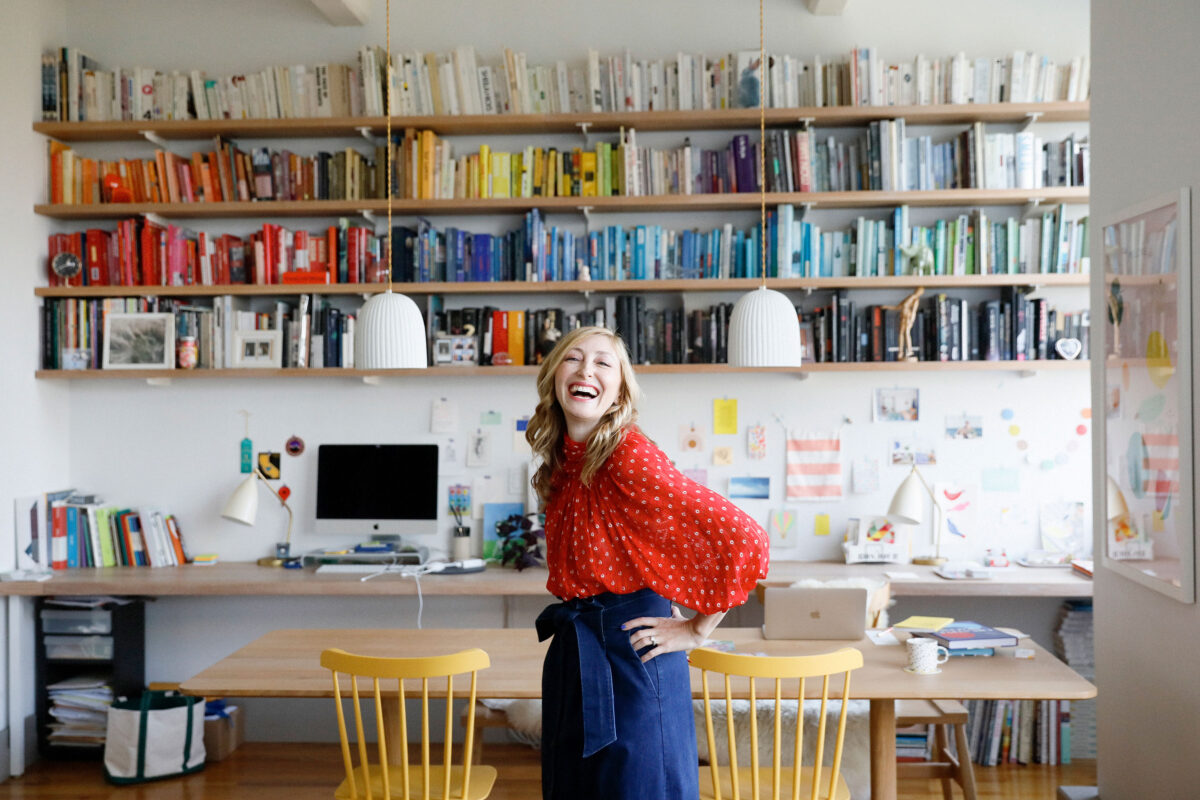
If you are looking to make a change in your home, sign-ups just opened for my free live workshop! We only host this popular offering once a year, so make sure you check our session schedule and save your seat ASAP.
It started with the yellow chairs.
When Albert and I first moved in together, we didn’t have a clear vision for how we wanted the space to look. (In fact, we often disagreed intensely about it, a topic I’ve written about here.) But when it came time to choose dining room chairs, we both were drawn to a set of sunny yellow Windsor-style chairs.
At the time, we had a gray sofa, which we’d been sold on as a nice, neutral option, an oak table, and a cream-and-black rug. And while we were lucky to have a view of the East River, the colors out the window were also gray gray gray.
Against this backdrop the yellow chairs were like turning on a lightbulb. Soon we added a pink poster with screen-printed melons, a forest green velvet sofa, and a chandelier that looked like a cluster of multicolored glass bubbles. We covered a wall with open shelves which I painstakingly color-coded. Soon we added plants, and throw pillows with a pop of unexpected red.
I didn’t realize it at the time, but we had discovered the power of “dopamine decor.”
What is Dopamine Decor?
Dopamine decor is the idea of decorating your space in a way that makes you feel good.
The dopamine decor trend emerged on TikTok as an offshoot of the “dopamine dressing” trend in fashion, where people dress in bright colors and bold patterns to boost their moods. The trend is named for dopamine, the neurotransmitter in the brain commonly associated with pleasure.
As a decorating philosophy, dopamine decor emphasizes using bright colors, bold patterns, and inviting textures to create a space that brings you joy. The idea is that each item of decor provides a little hit of pleasure in the brain, and that layering many of these pleasurable items together creates an environment that boosts your overall mental health.
Dopamine decor is an interesting counter-trend to “dopamine detox.” This trend, also known as dopamine fasting, emerged as a way to take a break from compulsive behaviors that often inhibit well-being, like responding to non-stop notifications, but evolved into a maladaptive practice of self-denial, where people give up a multitude of healthy and pleasurable behaviors in the misguided belief that they can “reset” their dopamine levels.
Instead of working to limit the effects of dopamine through the denial of pleasure, dopamine decor actively works to stimulate pleasure and create more joy in the spaces where you spend most of your time.
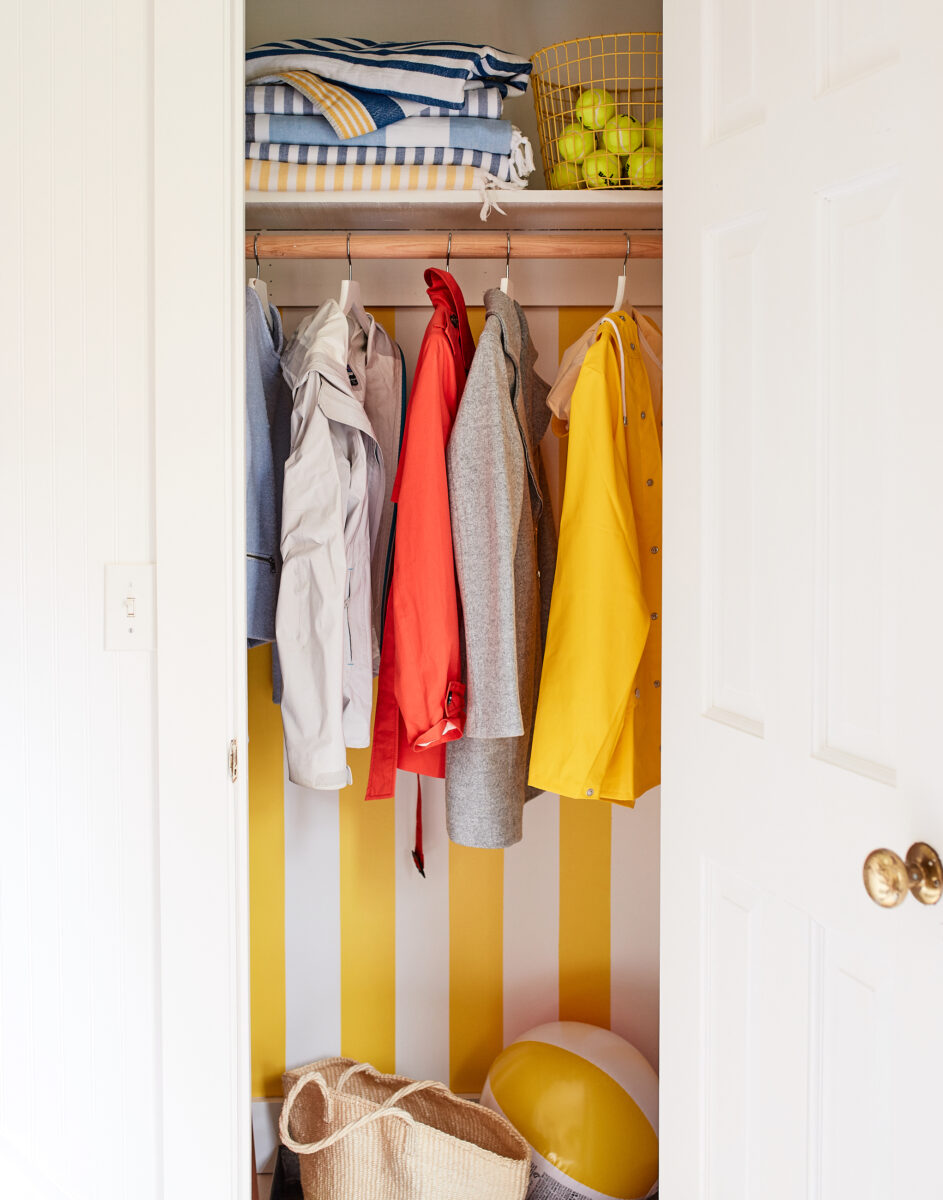
What is the Neuroscience of Dopamine Decor?
While dopamine is known as the “feel-good” neurotransmitter, it’s a bit more complex than simply dopamine = happiness. Yes, dopamine is associated with pleasure, but its role in the brain is actually much bigger.
Dopamine is central to what’s known as the reward pathway in the brain. When you take an action that increases your chances of survival or thriving, such as eating something that tastes good, the reward pathway is activated and dopamine is released, making you feel pleasure. Dopamine helps to reinforce an action, which makes it critical in the formation of habits and in motivation. But it also plays a central role in addiction.
It’s also important to note that there are other neurotransmitters and hormones that play a role in the neuroscience of happiness. These include serotonin (contributes to mood regulation), oxytocin (essential to bonding and belonging), norepinephrine (related to excitement and attraction), and endorphins (involved in pain and discomfort relief).
Does Dopamine Decor Really Work?
While it would probably more accurate to say “dopamine serotonin oxytocin norepinephrine and endorphin decor,” that’s a bit of a mouthful! So dopamine decor is a useful shorthand for the idea of designing joy-inducing spaces as a way of boosting mental health.
The basic idea behind dopamine decor is the same as the one at the heart of the Aesthetics of Joy and my book, Joyful: small, uplifting changes to your environment can have a meaningful influence on your daily sense of joy and well-being.
A plethora of research supports this idea. Here are some key findings:
Looking at Art Stimulates Activity in the Brain’s Reward Center
Perhaps the most convincing evidence for a link between design and dopamine is research done by neurobiologists Semir Zeki and Tomohiro Ishizu. This research scanned subjects’ brains as they looked at a range of different works of art. What Zeki’s team found is that when subjects looked at works of art they consider beautiful, there was an increase in activity in the reward center of the brain, the same area that is active when we’re in love, and where dopamine plays a significant role.
Sensory-Rich Environments Are More Restorative
Sensory-rich break rooms have been found to be more pleasant and restorative than a typical break room, making them more effective in helping people stress and increasing arousal. And research by Sampedro-Piquero et al. has shown that enriched environments have positive effects on multiple brain functions, such as reducing anxiety and improving brain connectivity.
Light and Color Impact Our Moods
In a cross-cultural study of people in their work environments, researchers found that people working in lighter, brighter workspaces were more alert, confident, friendly, and joyful than those working in drab spaces. And in a 2011 study by Yildirim et al., warm-colored interiors evoked exciting and stimulating responses. And cool-colored interiors evoked spacious and restful responses.
Vibrant Spaces Enhance Other Sensory Experiences
Vibrant spaces like those encouraged by dopamine decor may also enhance other sensory experiences, like making wine taste better. Take-with-a-grain-of-salt warning: the study that demonstrated this was sponsored by a winery, but its findings are consistent with research from Charles Spence’s Crossmodal Lab at Oxford, which specializes in the way sensory perceptions influence each other. For example, researchers have found that good lighting and pleasant music can enhance the taste of whatever we’re eating. Other research has shown that scents like lavender or soft music can make fabric swatches feel softer.
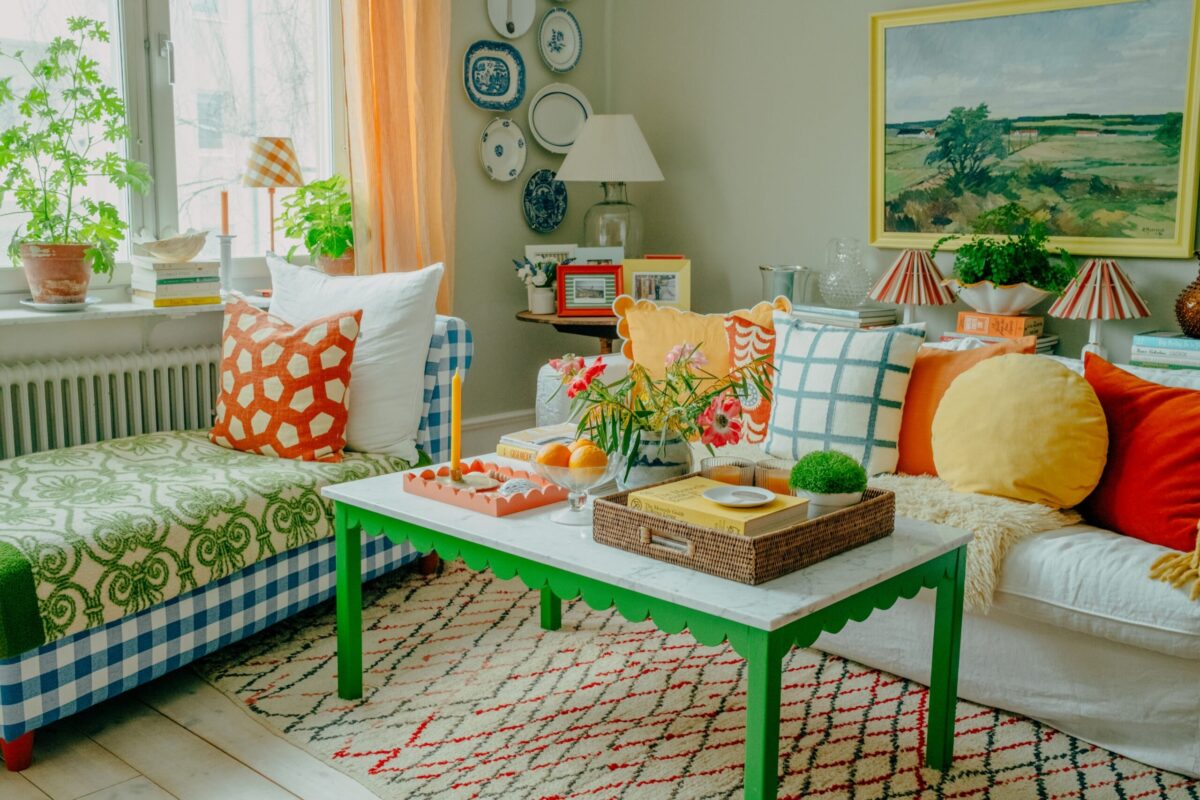
Dopamine Decor Trend Tips
While dopamine decor might be a bit of a buzzword, it’s a big step forward in restoring our emotional connection to our homes. Rather than seeing our spaces as just functional settings that should be minimal and undistracting, dopamine decor prompts us to get curious about what would make our spaces feel good.
Now that you know that dopamine decor is a valid approach to boosting mental health through design, how should you go about applying this idea in your space? Here are some tips:
Listen to Your Inner Child
Think back to how you may have decorated your room as a kid before you cared about having a specific style. Everything you kept in your room was something you truly loved. Dopamine decorating is just that—decorating with things you truly love. You don’t have to put up posters of rainbow unicorns or Care Bears (though you can if you want!) But letting your inner child help you decorate may help you access a freer, more playful version of your style.
Be Inspired by Places You Love
There are certain places that make you feel good as soon as you step inside. Maybe it’s your grandparents’ house, the local library, or your favorite coffee shop. What is it about these places that make you feel that way? Put your finger on any specific decor items that help to create that positive feeling. Just that is a great place to start.
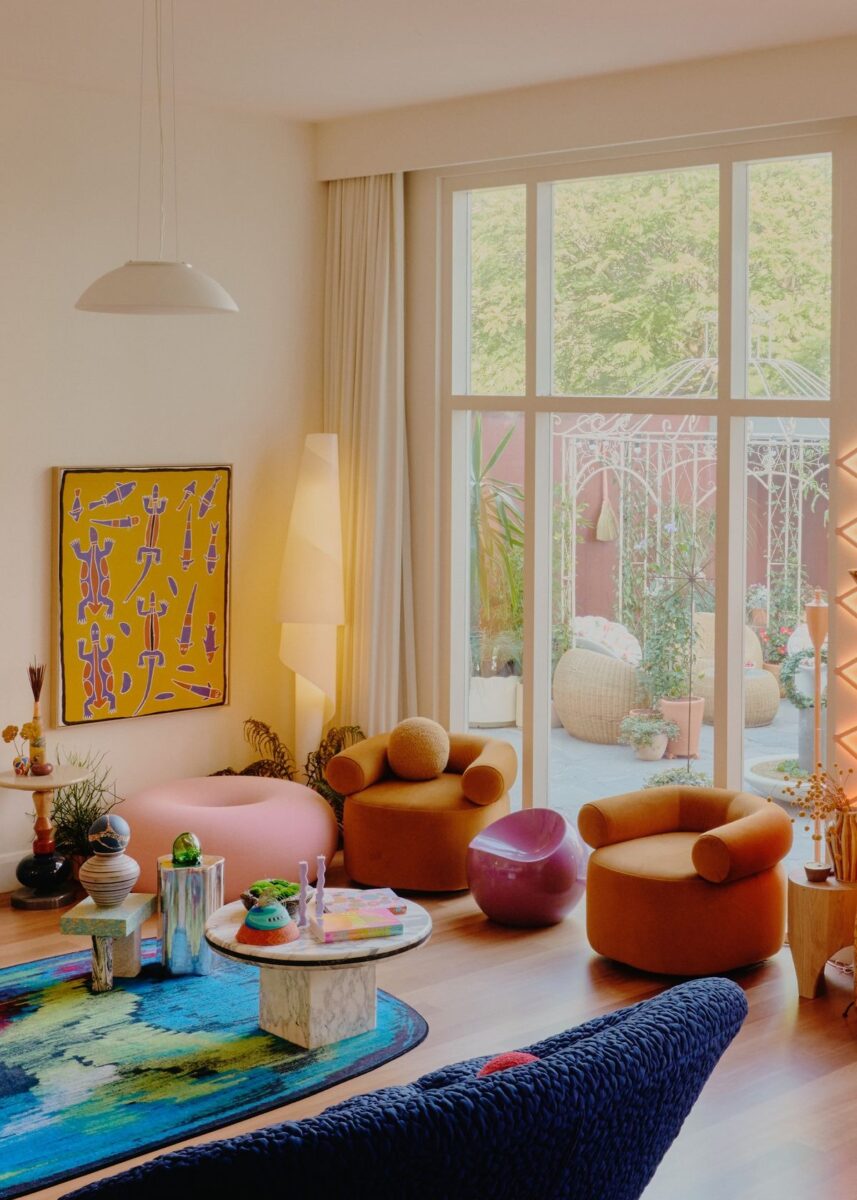
Go Bold with Color
Using color in your home is one of the best ways to immediately bring a burst of energy to a space. Bold hues are dynamic and stimulating, creating an environment that’s uplifting, invigorating, and exciting. Bright pinks, oranges, yellows, lime greens, and cobalt blues are colors commonly used in dopamine decor. But the most important thing is to choose colors you love.
Choose a Color Scheme
Because dopamine decor encourages a mix of colors, patterns, and overall aesthetics, there’s a risk that things can get a bit overwhelming. Sticking with a defined palette that brings you joy can help create a sense of cohesion and harmony.
Decorate to Inspire Good Habits
Because dopamine plays a role in motivation and habit formation, the principles of dopamine decor can be a great tool to help you foster good habits. Getting a brightly colored water bottle, for example, can remind you to refill it. Making your workout area vibrant can draw you to exercise rather than just sit on the sofa.
Focus on Areas That Help You Live Better
If you want to have more fun family dinners, then start by adding color to your table. If you want to read more, make a vibrant reading nook.
On the flip side, because dopamine plays a role in addiction, you may want to avoid dopamine decor in areas where you have trouble setting healthy limits. If you’re trying to give up alcohol, a colorful bar cart is the opposite of helpful. And if you find it hard to turn off the TV once you’ve started watching, a colorful TV room might keep you in couch potato mode longer. Instead, focus the color and joy on other areas of your space.
Design for Abundance
The prevalence of minimalism has made a lot of us feel we need to rein in our taste or else risk being seen as gaudy. On the contrary, maximalism, or what we at the Aesthetics of Joy call abundance, provides the chance to decorate more freely with fewer constraints. Removing limitations and being surrounded by a sensorially rich environment may also support an overall abundance mindset. Exploring abundance and variety can help you create a joyful home out of items you already have, layered with things you love.
Shop Vintage and Second-Hand
Buying home decor from thrift stores, garage sales, or online resale sites gives an opportunity to find one-of-a-kind items you love outside of the pressures of trends or algorithms. Bringing these unique decor items together in your space produces a style specific to you and your personal tastes. You’re also creating the sense of individuality and personality that dopamine decor encourages.
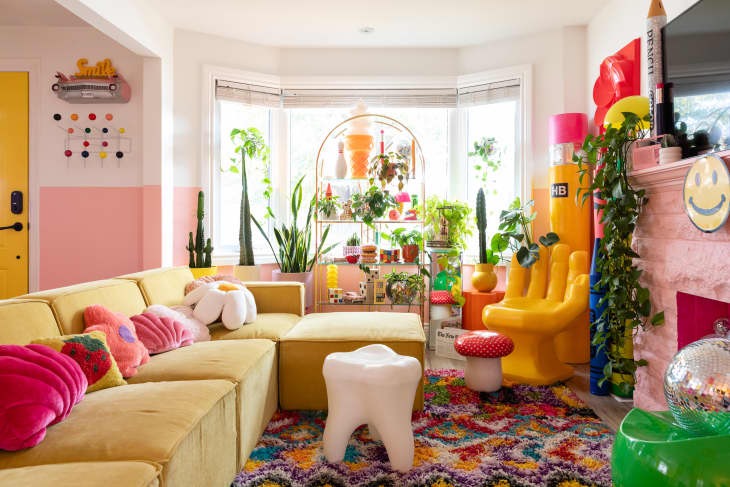
Lean into Whimsy
Novelty furniture or decor shaped like animals, plants, foods, or any other unconventional objects can bring a surprising, playful quality to your space. If this feels too much for you, decorating with whimsical knick-knacks or ornaments is a smaller yet still effective way to foster playfulness and eccentricity, adding character and personality to your living space.
Don’t Forget About the Lighting
Lighting can be powerful for setting the mood of a space. Multiple light sources are usually the way to go for a layered and well-lit space. Lamps, candles, and string lights all have a warmer ambiance, making a space feel cozier. These lights can also help a space feel more cohesive, as overly-bright overhead lights tend to exaggerate or harshen differences in an eclectic space.
Mix and Match Styles
The freedom dopamine decor allows encourages drawing from different aesthetics and blending them together to create something new and creative. Instead of focusing on how to follow the rules of any one design aesthetic, pick and choose what you love from different styles to create your own personal collected look.
Wait Out Trends
Even though dopamine decor itself emerged as a trend, it works best when you avoid fleeting fads and tune into what you really love. Allow yourself to take your time to figure out what you love and what you will continue to love for a long time.
Start Small
Decor trends can often make you feel like you need to overhaul your entire space and start over. But because there is not one specific look to dopamine decor, it can be achieved on a much smaller scale. Start with just one decor item that brings you joy, and notice just how much even one change can transform how you feel in your home.
Sources:
- Chambers, 2023
- Ishizu and Zeki, 2011
- Kuller et al, 2006
- Sampedro-Piquero et al, 2018
- Sona et al., 2017
- Spence, 2022
- Yildirim et al, 2011
Research and writing for this post was contributed by Ava BooydeGraaff.
more feelgood design inspiration
- 7 ways to create joy in a rental
- How to add pops of color to your home on a budget
- How to avoid impulse buying and find items you’ll love for the long-haul
- How to make a home feel unique and personal
Reminder: My free live home workshop is coming soon! Learn how to create a home you love without moving, renovating, or spending money you don’t have. Save your seat right here.

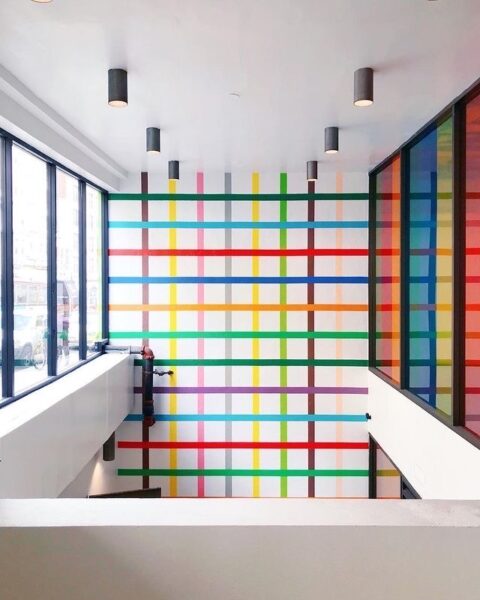
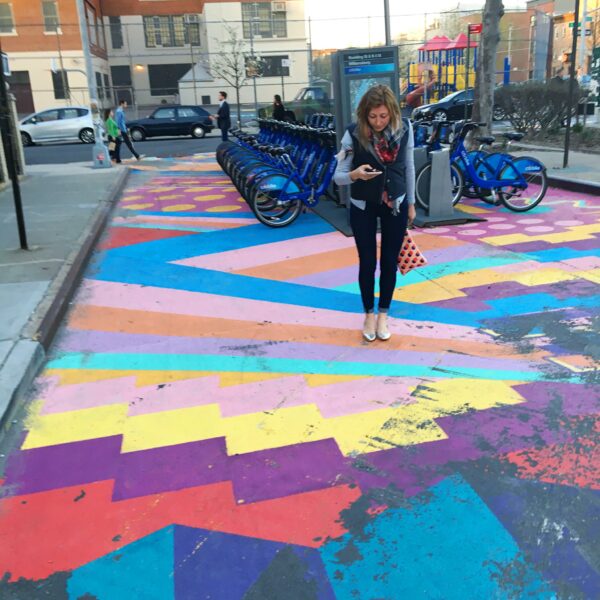

Leave a Comment